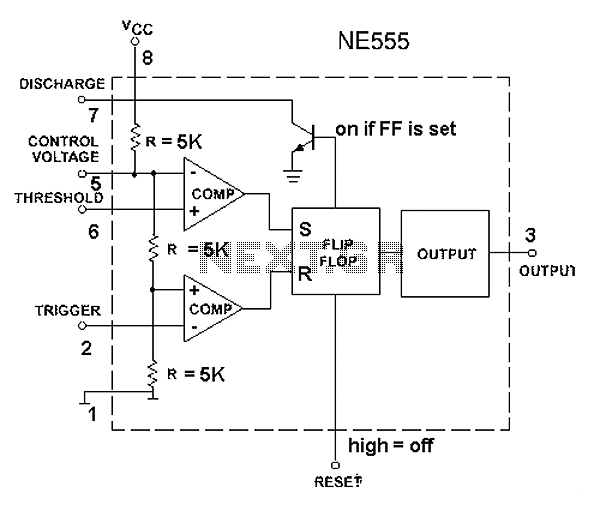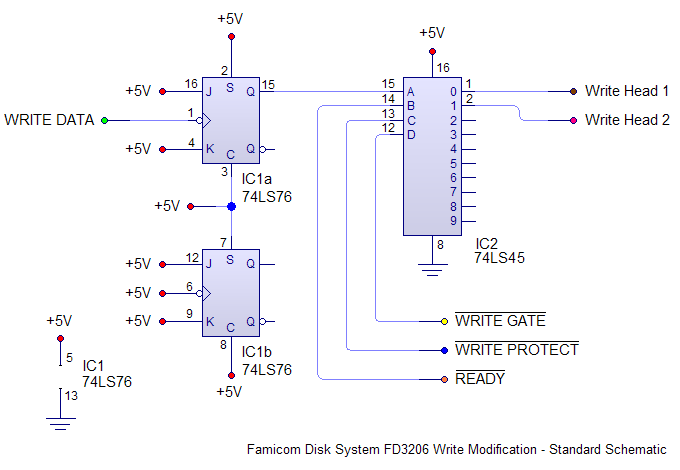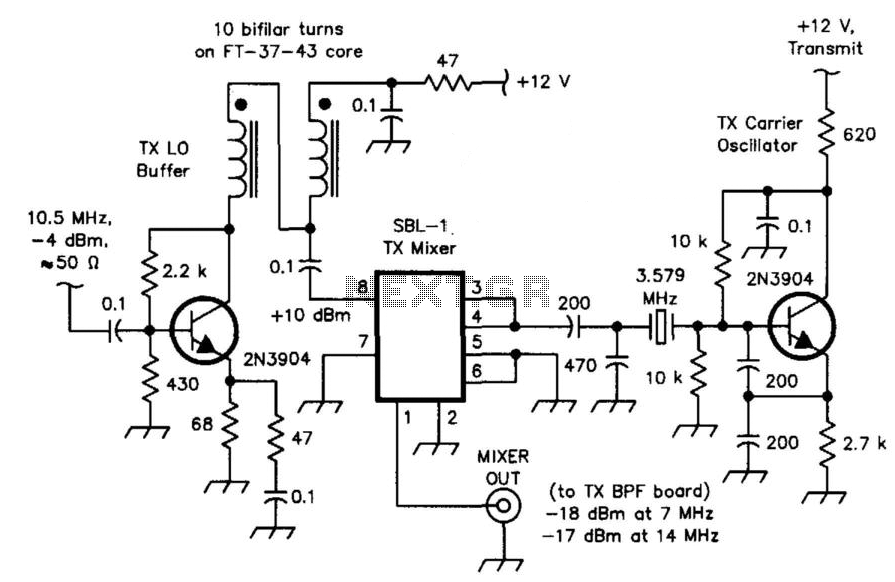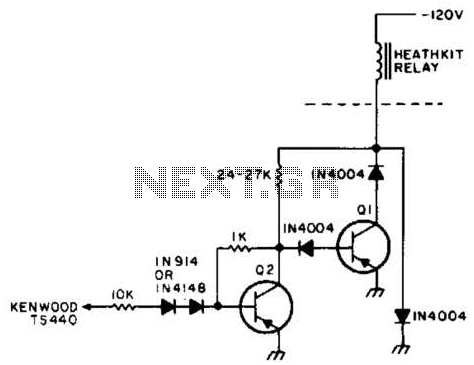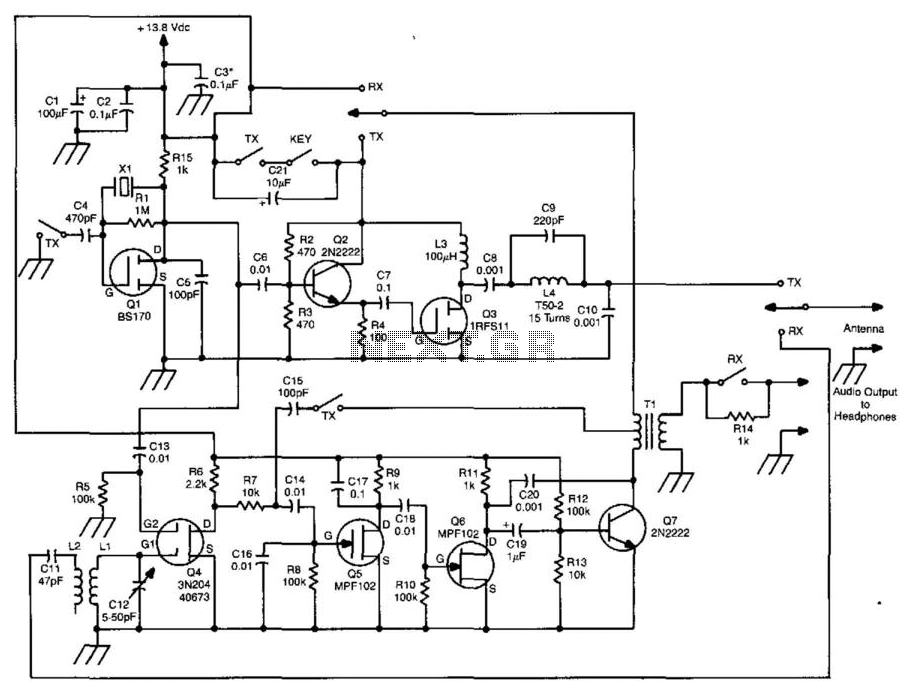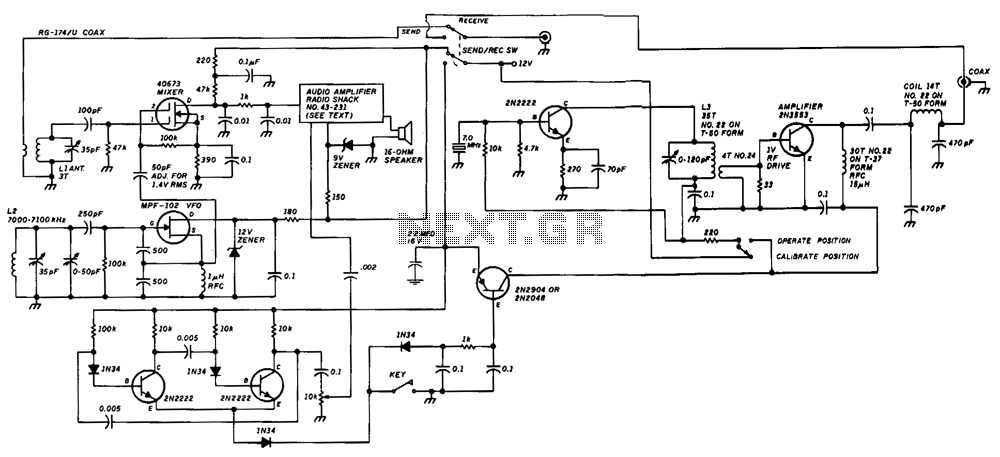
Icom IC-751 (IC 751 IC751) transceiver mods reviews software and diagrams

The 751 required turning the volume control almost to the 12 o'clock position before achieving any noticeable volume, which raised concerns about potential issues. To address this, all electrolytic capacitors associated with the audio path, specifically after the detector stage and the audio amplifier, were replaced. Although no audible difference was detected, this action provided some reassurance. Subsequently, an oscilloscope was utilized to investigate the source of the thumping noise. The 751 employs two electronic switches (IC7 C and D) to mute the audio; one switch controls the audio output, while the other manages the monitor/sidetone circuit. Oscilloscope readings suggested that these switches might be responsible for the generated pulses during their operation. It was initially overlooked that a substantial positive pulse occurred when switching to transmit, while a large negative pulse was generated upon switching back to receive. After further investigation, traces were cut, and jumpers were added to effectively bypass the electronic switches, connecting the monitor and audio stages directly to the audio amplifier without switching. This modification alleviated the thumping issue but resulted in the loss of squelch functionality and a significant reduction in volume. Further exploration revealed that electronic switches were unnecessary for continuous wave (CW) operation, as the receiver effectively mutes without them, and the monitor/sidetone function operates only when the key is pressed. The electronic switches were primarily required for squelch operation; however, the circuit design of the 751 turned off the audio path during transmission while activating the monitor/sidetone audio path. In contrast, the 761 utilizes transistors to ground the audio path during transmission. A small circuit was constructed to replicate this function using the squelch lead for control, but the same thumping noise persisted, accompanied by identical pulses in the audio input. The audio amplifier in the 751 maintains full gain continuously, with volume control achieved by varying the attenuation in IC 6A, which is in series with the audio path. Consequently, the audio signal remains very low in preceding stages, making it difficult for the oscilloscope to capture the levels accurately. To address this, a small amplifier was built for the oscilloscope to examine the audio at various points. It was discovered that both the attenuator IC and the buffer amplifier for the monitor/sidetone feature series capacitors connected to the audio amplifier. Initial assumptions categorized these as coupling capacitors, but they function primarily as DC blocking capacitors. The audio path includes a series electrolytic capacitor, and it became evident that these capacitors were charging and discharging in response to the activation of the squelch lead (audio) or the transmit 8-volt (monitor/sidetone) line, resulting in the observed positive and negative pulses on the audio line.
The circuit design of the 751 audio system incorporates several critical components and configurations that affect its performance and functionality. The audio path begins after the detector stage, where the audio signal is processed through a series of electrolytic capacitors, which serve to block DC components while allowing AC audio signals to pass. These capacitors are crucial in maintaining the integrity of the audio signal by preventing unwanted DC offset from interfering with the audio processing.
The electronic switches (IC7 C and D) play a pivotal role in muting the audio during transmission and managing the monitor/sidetone circuit. Their operation is essential for ensuring that the audio path is correctly configured depending on the mode of operation—receive or transmit. However, their inherent switching characteristics can introduce unwanted transients into the audio path, particularly when switching states. The observed thumping noise was likely caused by these transients, which were exacerbated by the high gain of the audio amplifier.
The audio amplifier itself is designed to operate at full gain continuously, with the volume control implemented through attenuation in IC 6A. This design choice leads to very low audio signal levels in the earlier stages of the circuit, making it challenging to diagnose issues with standard measurement tools. The addition of a dedicated amplifier for the oscilloscope allowed for better visibility of these low-level signals and facilitated the identification of the actual problem—charging and discharging behavior of the DC blocking capacitors in the audio path.
The modifications made to bypass the electronic switches and connect the audio and monitor stages directly to the audio amplifier provided a temporary solution to the thumping issue but also highlighted the need for careful consideration of the circuit's design and functionality. The discovery that the electronic switches were not necessary for CW operation further emphasizes the importance of understanding the specific requirements of the audio path in various operating modes.
In conclusion, the 751 audio circuit showcases the interplay between component design, signal integrity, and operational functionality. The careful selection of capacitors, the role of electronic switches, and the configuration of the audio amplifier all contribute to the overall performance of the system. Understanding these elements is essential for effective troubleshooting and optimization of audio systems in similar applications.The 751 required turning the volume control almost to 12 o`clock before getting any hearable volume so I thought maybe something was wrong here. I replaced all the electrolytics associated with the audio path, i. e. after the detector stage and the audo amp. I couldn`t really hear any difference but at least I felt better. At this point, I dug out the scope and started looking at where the thumping was coming from. The 751 uses two electronic switches (IC7 C and D) to mute the audio, one for the actual audio and one for the monitor/sidetone circuit. The scope indicated that maybe these were causing the pulses generated when they were switched. (I should have realized at this point that this wasn`t the case because when switching to transmit a large positive pulse occured and when switching back to recieve a large negative pulse was generated.
I figured out later what was happening. ) Anyway, I started cutting traces and adding jumpers and effectively bypassed the electronic switches. What I ended up doing was connecting the monitor and audio stages to the audio amp with no switching.
This basically fixed the problem but I lost the use of squelch and the volume was reduced quite a bit. So I started looking elsewhere. A couple of things I learned was that the electronic switches were not needed for cw operation. The receiver mutes very well without them and the monitor/sidetone only works when the key is down. This is exactly what was needed. The electronic switches are really only needed for squelch operation but the circuit designers built the 751 so that the audio path is switched off when going to transmit and the monitor/sidetone audio path is switched on when in transmit.
The 761 uses a couple of transistors to "short" the audio path to ground when in transmit. I built up a little circuit to do the same thing using the squelch lead to control it. Lo and behold, I got the same thumps and when looking at the audio input the same pulses were there. I said to myself, self, what is going on. The audio amp in the 751 runs at full gain all the time. The volume is varied by changing the amount of attenuation in IC 6A that is in series with the audio path. Since the amp runs at full gain, the audio signal is very, very low in the preceding stages. My scope just wouldn`t show the levels since they were so low. So I built up a little amplifier for the scope to look at the audio at each point. Guess what I found Both the attenuator IC and the buffer amp for the monitor/sidetone have series capacitors feeding the audio amp.
I just assumed these were coupling capacitors and wouldn`t have any effect. WRONG! They are really DC blocking capacitors more than coupling capacitors. In fact, the audio path has a series electrolytic capacitor. What was happening is that these capacitors were being charged and discharged when the squelch lead (audio) or transmit 8 volt (monitor/sidetone) line activated. This is what was causing the positive and negative pulses on the audio line. With the high gain 🔗 External reference
The circuit design of the 751 audio system incorporates several critical components and configurations that affect its performance and functionality. The audio path begins after the detector stage, where the audio signal is processed through a series of electrolytic capacitors, which serve to block DC components while allowing AC audio signals to pass. These capacitors are crucial in maintaining the integrity of the audio signal by preventing unwanted DC offset from interfering with the audio processing.
The electronic switches (IC7 C and D) play a pivotal role in muting the audio during transmission and managing the monitor/sidetone circuit. Their operation is essential for ensuring that the audio path is correctly configured depending on the mode of operation—receive or transmit. However, their inherent switching characteristics can introduce unwanted transients into the audio path, particularly when switching states. The observed thumping noise was likely caused by these transients, which were exacerbated by the high gain of the audio amplifier.
The audio amplifier itself is designed to operate at full gain continuously, with the volume control implemented through attenuation in IC 6A. This design choice leads to very low audio signal levels in the earlier stages of the circuit, making it challenging to diagnose issues with standard measurement tools. The addition of a dedicated amplifier for the oscilloscope allowed for better visibility of these low-level signals and facilitated the identification of the actual problem—charging and discharging behavior of the DC blocking capacitors in the audio path.
The modifications made to bypass the electronic switches and connect the audio and monitor stages directly to the audio amplifier provided a temporary solution to the thumping issue but also highlighted the need for careful consideration of the circuit's design and functionality. The discovery that the electronic switches were not necessary for CW operation further emphasizes the importance of understanding the specific requirements of the audio path in various operating modes.
In conclusion, the 751 audio circuit showcases the interplay between component design, signal integrity, and operational functionality. The careful selection of capacitors, the role of electronic switches, and the configuration of the audio amplifier all contribute to the overall performance of the system. Understanding these elements is essential for effective troubleshooting and optimization of audio systems in similar applications.The 751 required turning the volume control almost to 12 o`clock before getting any hearable volume so I thought maybe something was wrong here. I replaced all the electrolytics associated with the audio path, i. e. after the detector stage and the audo amp. I couldn`t really hear any difference but at least I felt better. At this point, I dug out the scope and started looking at where the thumping was coming from. The 751 uses two electronic switches (IC7 C and D) to mute the audio, one for the actual audio and one for the monitor/sidetone circuit. The scope indicated that maybe these were causing the pulses generated when they were switched. (I should have realized at this point that this wasn`t the case because when switching to transmit a large positive pulse occured and when switching back to recieve a large negative pulse was generated.
I figured out later what was happening. ) Anyway, I started cutting traces and adding jumpers and effectively bypassed the electronic switches. What I ended up doing was connecting the monitor and audio stages to the audio amp with no switching.
This basically fixed the problem but I lost the use of squelch and the volume was reduced quite a bit. So I started looking elsewhere. A couple of things I learned was that the electronic switches were not needed for cw operation. The receiver mutes very well without them and the monitor/sidetone only works when the key is down. This is exactly what was needed. The electronic switches are really only needed for squelch operation but the circuit designers built the 751 so that the audio path is switched off when going to transmit and the monitor/sidetone audio path is switched on when in transmit.
The 761 uses a couple of transistors to "short" the audio path to ground when in transmit. I built up a little circuit to do the same thing using the squelch lead to control it. Lo and behold, I got the same thumps and when looking at the audio input the same pulses were there. I said to myself, self, what is going on. The audio amp in the 751 runs at full gain all the time. The volume is varied by changing the amount of attenuation in IC 6A that is in series with the audio path. Since the amp runs at full gain, the audio signal is very, very low in the preceding stages. My scope just wouldn`t show the levels since they were so low. So I built up a little amplifier for the scope to look at the audio at each point. Guess what I found Both the attenuator IC and the buffer amp for the monitor/sidetone have series capacitors feeding the audio amp.
I just assumed these were coupling capacitors and wouldn`t have any effect. WRONG! They are really DC blocking capacitors more than coupling capacitors. In fact, the audio path has a series electrolytic capacitor. What was happening is that these capacitors were being charged and discharged when the squelch lead (audio) or transmit 8 volt (monitor/sidetone) line activated. This is what was causing the positive and negative pulses on the audio line. With the high gain 🔗 External reference
